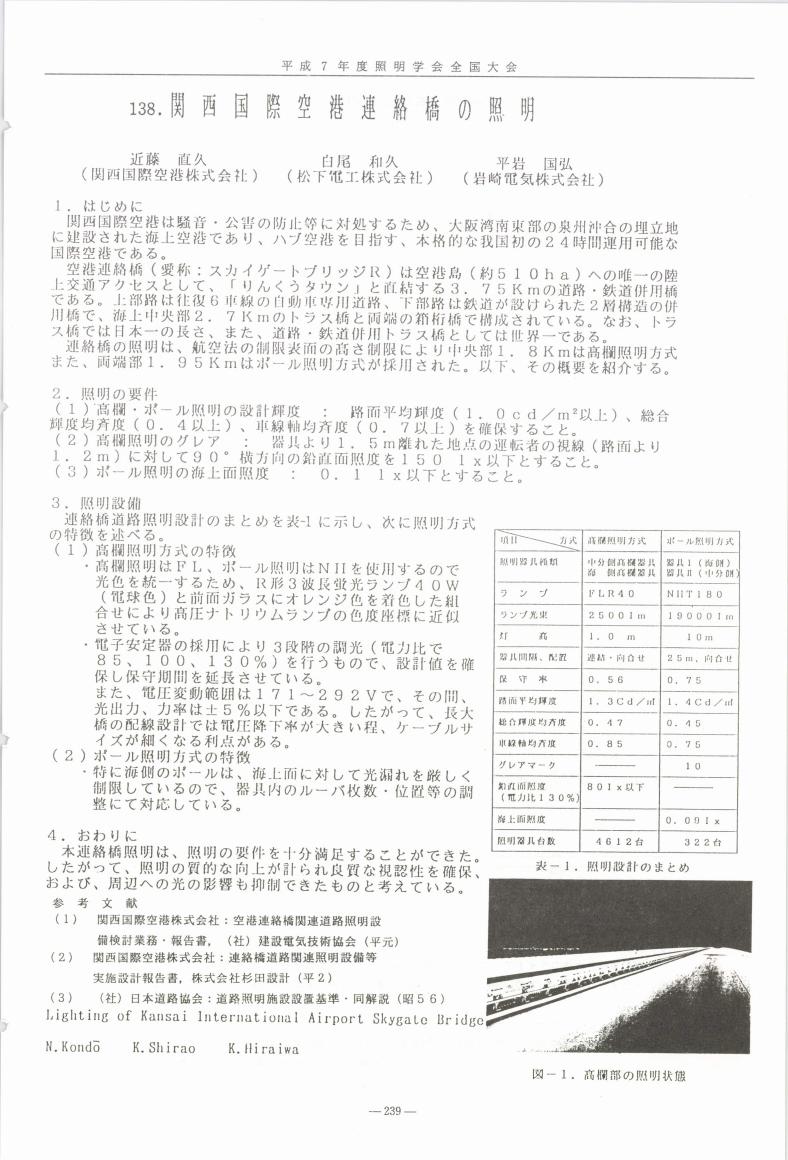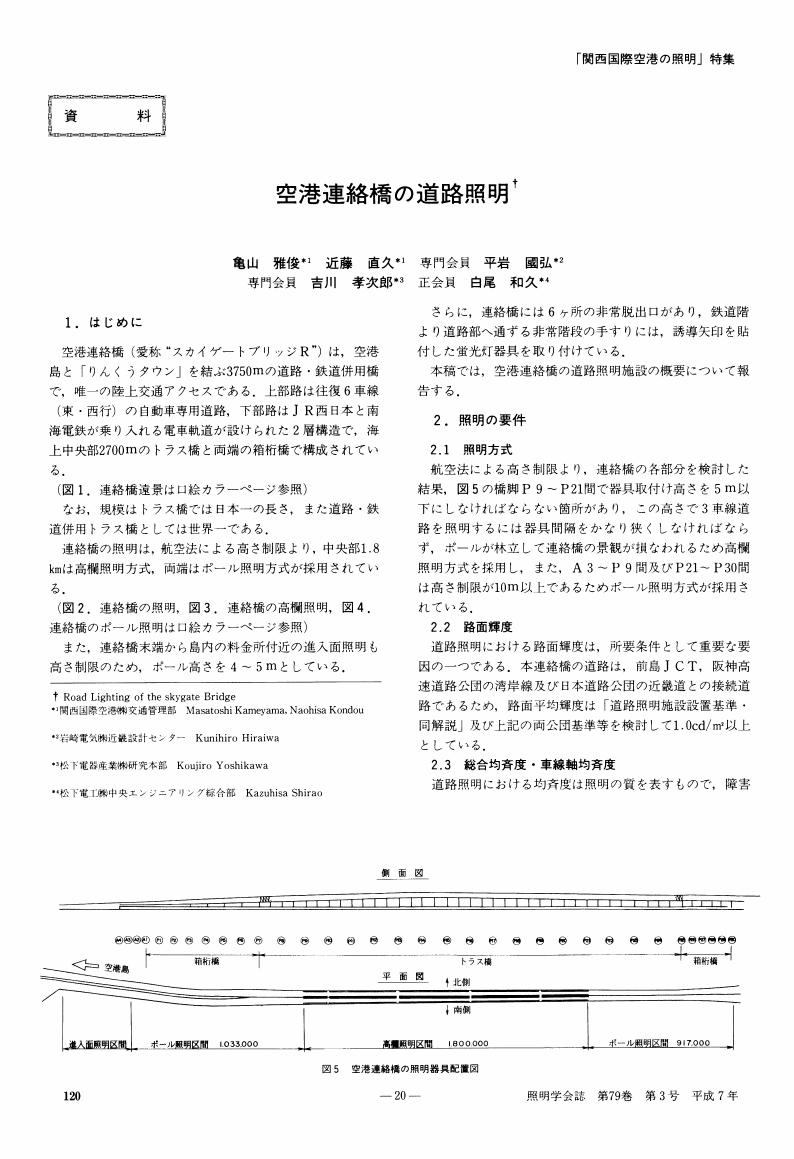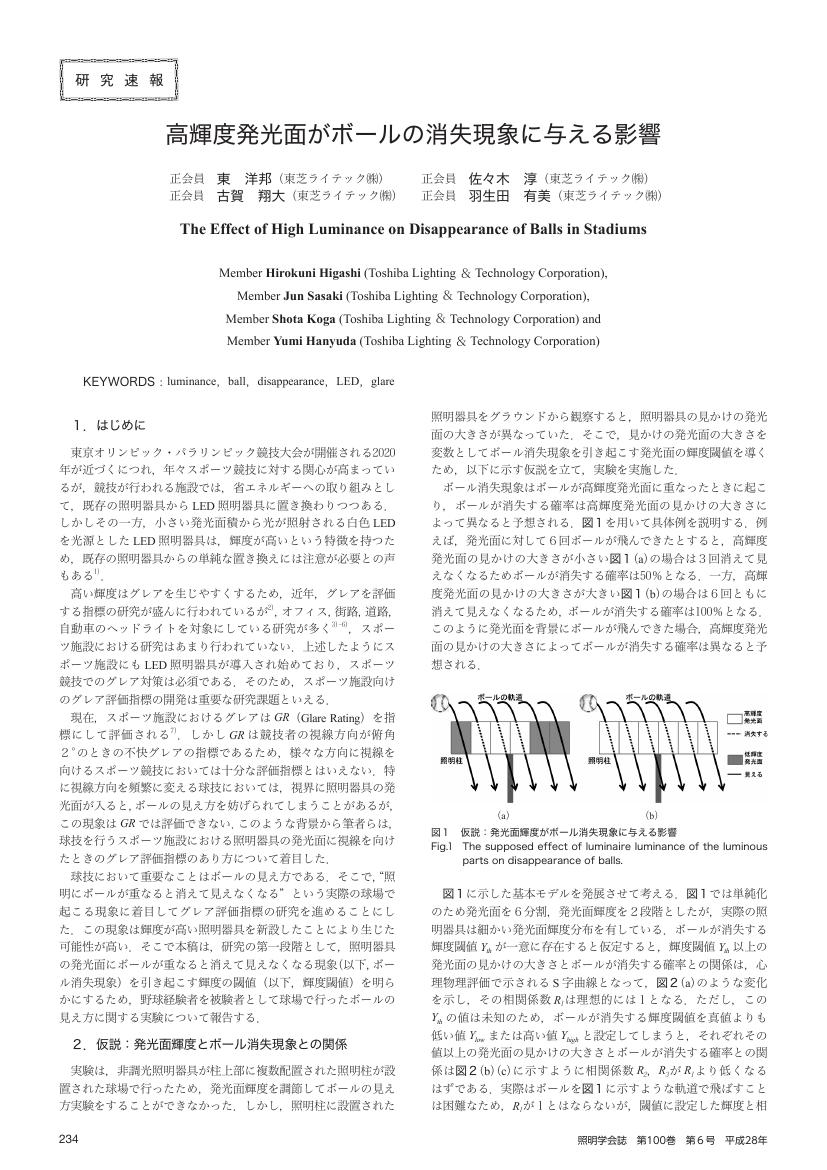1 0 0 0 OA 測光用光センサのオーバーフィル照射における応答非直線性の評価法の確立
- 著者
- 田辺 稔 木下 健一
- 出版者
- 一般社団法人 照明学会
- 雑誌
- 照明学会誌 (ISSN:00192341)
- 巻号頁・発行日
- pp.180000579, (Released:2019-04-26)
- 参考文献数
- 17
1 0 0 0 資料: 合同技術委員会報告
1 0 0 0 OA 関西国際空港連絡橋の照明
- 著者
- 近藤 直久 白尾 和久 平岩 国弘
- 出版者
- 一般社団法人 照明学会
- 雑誌
- 照明学会誌 (ISSN:00192341)
- 巻号頁・発行日
- vol.79, no.Appendix, pp.239, 1995-03-31 (Released:2011-07-19)
- 参考文献数
- 3
1 0 0 0 OA 空港連絡橋の道路照明
- 著者
- 亀山 雅俊 近藤 直久 平岩 國弘 吉川 孝次郎 白尾 和久
- 出版者
- 一般社団法人 照明学会
- 雑誌
- 照明学会誌 (ISSN:00192341)
- 巻号頁・発行日
- vol.79, no.3, pp.120-123, 1995-03-01 (Released:2011-07-19)
- 参考文献数
- 3
1 0 0 0 国立屋内総合競技場
- 著者
- 大滝 基
- 出版者
- 一般社団法人 照明学会
- 雑誌
- 照明学会雑誌 (ISSN:00192341)
- 巻号頁・発行日
- vol.49, no.3, pp.124-129, 1965
1 0 0 0 OA 八幡丸の照明
- 出版者
- 一般社団法人 照明学会
- 雑誌
- 照明学会雑誌 (ISSN:00192341)
- 巻号頁・発行日
- vol.25, no.6, pp.plate1-plate6, 1941 (Released:2011-02-09)
1 0 0 0 OA 新田丸の照明設備に就て
- 著者
- 間崎 秀夫
- 出版者
- 一般社団法人 照明学会
- 雑誌
- 照明学会雑誌 (ISSN:00192341)
- 巻号頁・発行日
- vol.24, no.7, pp.3-18, 1940 (Released:2011-02-09)
1 0 0 0 OA エジソン発明以降100年の電球の発達
- 著者
- 染谷 彰
- 出版者
- 一般社団法人 照明学会
- 雑誌
- 照明学会雑誌 (ISSN:00192341)
- 巻号頁・発行日
- vol.63, no.10, pp.609-613, 1979-10-25 (Released:2011-07-19)
1 0 0 0 OA 車両照明
- 著者
- 内田 重春
- 出版者
- 一般社団法人 照明学会
- 雑誌
- 照明学会雑誌 (ISSN:00192341)
- 巻号頁・発行日
- vol.46, no.9, pp.459-461, 1962-09-25 (Released:2011-07-19)
1 0 0 0 OA 高輝度発光面がボールの消失現象に与える影響
- 著者
- 東 洋邦 佐々木 淳 古賀 翔大 羽生田 有美
- 出版者
- 一般社団法人 照明学会
- 雑誌
- 照明学会誌 (ISSN:00192341)
- 巻号頁・発行日
- vol.100, no.6, pp.234-237, 2016-06-01 (Released:2016-10-01)
- 参考文献数
- 7
- 被引用文献数
- 2
- 著者
- 松田 宗太郎
- 出版者
- 一般社団法人 照明学会
- 雑誌
- 照明学会雑誌 (ISSN:00192341)
- 巻号頁・発行日
- vol.61, no.12, pp.728-729, 1977
1 0 0 0 大阪・御堂筋いちょう並木のイルミネーション装飾設備
- 著者
- 宮崎 研一 大田 領一 石井 幹子 反町 仁志
- 出版者
- 一般社団法人 照明学会
- 雑誌
- 照明学会雑誌 (ISSN:00192341)
- 巻号頁・発行日
- vol.80, pp.213, 1996
1 0 0 0 OA 明るさの知覚
- 著者
- 武内 徹二
- 出版者
- 一般社団法人 照明学会
- 雑誌
- 照明学会誌 (ISSN:00192341)
- 巻号頁・発行日
- vol.81, no.6, pp.493-499, 1997-06-01 (Released:2011-07-19)
- 参考文献数
- 16
- 被引用文献数
- 1 2
1 0 0 0 色モード境界輝度による空間の明るさ感評価
- 著者
- 山口 秀樹 篠田 博之
- 出版者
- 一般社団法人照明学会
- 雑誌
- 照明学会誌 = JOURNAL OF THE ILLUMINATING ENGINEERING INSTITUTE OF JAPAN (ISSN:00192341)
- 巻号頁・発行日
- vol.91, no.5, pp.266-271, 2007-05-01
- 参考文献数
- 11
- 被引用文献数
- 13 8
In previous study, we defined the border luminance as space brightness and investigated what determines border luminance in a real environment. We undertook a second study to confirm that perceived brightness of a room is determined solely by border luminance. We also examined the correlation between change in the magnitude of space brightness and change in the border luminance. To investigate these two points, we measured space brightness using three methods: magnitude estimation, space-brightness matching, and border-luminance adjustment. We found that, the border luminance is the same even though the illuminance of the room or the configuration of interior surface reflectance is different, the matched illuminance is the same. The brightness value obtained using the magnitude estimation method was proportional to the 0.56-th power of the border luminance. Our results clearly show that space brightness can be evaluated quantitatively using border luminance adjustment even if the brightness cannot be measured using the horizontal illuminance. Therefore, measuring the border luminance is an effective way to supplement existing photometric systems.
1 0 0 0 Hg-Ne放電管のエンドライトの発光特性について
- 著者
- 青野 正明 黒河 久悦 久保 寔 板谷 良平
- 出版者
- 一般社団法人 照明学会
- 雑誌
- 照明学会雑誌 (ISSN:00192341)
- 巻号頁・発行日
- vol.68, pp.58, 1984
1 0 0 0 各界よりの寄稿:照明学会創立60周年を祝して
- 著者
- 大平 恵一 河窪 登志夫 木俣 三郎 金原 正 佐山 泰浩 鈴木 正 山崎 修
- 出版者
- The Illuminating Engineering Institute of Japan
- 雑誌
- 照明学会雑誌 (ISSN:00192341)
- 巻号頁・発行日
- vol.60, no.12, pp.672-677, 1976
1 0 0 0 OA 光源の相関色温度と不快グレアに関する一考察
- 著者
- 清水 正則 岡村 泉 井上 猛
- 出版者
- 一般社団法人 照明学会
- 雑誌
- 照明学会誌 (ISSN:00192341)
- 巻号頁・発行日
- vol.74, no.Appendix, pp.72, 1990-03-30 (Released:2011-07-19)
- 参考文献数
- 1
1 0 0 0 OA 高齢者の不快グレア
- 著者
- 矢野 正 金谷 末子 市川 一夫
- 出版者
- 一般社団法人 照明学会
- 雑誌
- 照明学会誌 (ISSN:00192341)
- 巻号頁・発行日
- vol.77, no.6, pp.296-303, 1993-06-01 (Released:2011-07-19)
- 参考文献数
- 15
- 被引用文献数
- 7 7
It is well known that older people are more sentitive to discomfort glare than young people. This sensitivity is one of the visual problems that go with aging. On the relationship between discomfort glare and an observer's age, Bennett has already reported that older people produce lower BCDs (Borderline between Comfort and Discomfort) than young people. It is also known that the discomfort glare is affected by the color temperature of the light sources used, but this effect has not been clarified quantitatively.In order to clarify the quantitative relationship between the discomfort glare and the color temperature of light sources, we conducted a series of experiments on the discomfort glare for light sources with different color temperatures. The results are as follows (1) Both old and young observers are more sensitive to discomfort glare for the light sources with high color temperatures than for those with low color temperatures.(2) The effects of the color temperatures on the discomfort glare are about the same for both old and young observers.(3) The spectral distribution of light sources has no effect on the discomfort glare, if these color temperatures are constant.
1 0 0 0 OA 高齢者の視覚
- 著者
- 鵜飼 一彦
- 出版者
- 一般社団法人 照明学会
- 雑誌
- 照明学会誌 (ISSN:00192341)
- 巻号頁・発行日
- vol.80, no.7, pp.463-466, 1996-07-01 (Released:2011-07-19)
- 参考文献数
- 7
1 0 0 0 OA 三刺激値計算のための重価係数の求めかた
- 著者
- 大久保 和明 側垣 博明
- 出版者
- 一般社団法人 照明学会
- 雑誌
- 照明学会誌 (ISSN:00192341)
- 巻号頁・発行日
- vol.77, no.6, pp.364-370, 1993-06-01 (Released:2011-07-19)
- 参考文献数
- 4
For reflecting or transmitting object colours, the CIE tristimulus vslues of a colour stimulus are obtained by multiplying, at each wavelength, the value of the weigthing factors by that of each of the spectral reflectance or the spectral transmittance of the object colour. Then each set of products is integrated over the wavelength range corresponding to the entire visible spectrum, 380 to 780nm. The integration may be carried out by numerical summation at a wavelength interval, equal to 5nm. The weigthing factors are obtained by multiplying, at each wavelength, the value of the relative spectral power distribution of the illuminant by the CIE colour-matching functions.In practical applications, all the required data may not be available because of measurement at greater intervals intervals than 5nm, equal to the 10nm or 20nm intervals data. In this paper, the method for the calculation of the weigthing factors for the 10nm or 20nm intervals measurenent data using interpolation is reported.










